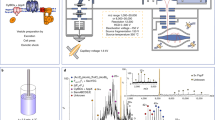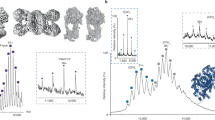Abstract
Interactions between lipids and proteins in the aqueous phases of cells contribute to many aspects of cell physiology. Here we describe a detailed protocol to systematically characterize in vivo–assembled complexes of soluble proteins and lipids. Saccharomyces cerevisiae strains expressing physiological amounts of a protein of interest fused to the tandem-affinity purification (TAP) tag are first lysed in the absence of detergent to capture intact protein-lipid complexes. The affinity-purified complexes (typically 30–50 kDa) are subjected to analytical size-exclusion chromatography (SEC) to remove contaminating lipids that elute at the void volume (>600 kDa), in order to achieve sufficient signal-to-background lipid ratios. Proteins in the SEC fractions are then analyzed by denaturing gel electrophoresis. Lipidomics techniques such as high-performance thin-layer chromatography or gas or liquid chromatography–mass spectrometry can then be applied to measure the elution profiles of lipids and to pinpoint the true interactors co-eluting with the TAP fusions. The procedure (starting from cell lysis) requires 2 d, and it can easily be adapted to other organisms.
This is a preview of subscription content, access via your institution
Access options
Subscribe to this journal
Receive 12 print issues and online access
$259.00 per year
only $21.58 per issue
Buy this article
- Purchase on Springer Link
- Instant access to full article PDF
Prices may be subject to local taxes which are calculated during checkout



Similar content being viewed by others
References
Zhu, H. et al. Global analysis of protein activities using proteome chips. Science 293, 2101–2105 (2001).
Yu, J.W. et al. Genome-wide analysis of membrane targeting by S. cerevisiae pleckstrin homology domains. Mol. Cell 13, 677–688 (2004).
Park, W.S. et al. Comprehensive identification of PIP3-regulated PH domains from C. elegans to H. sapiens by model prediction and live imaging. Mol. Cell 30, 381–392 (2008).
Li, X.Y., Gianoulis, T.A., Yip, K.Y., Gerstein, M. & Snyder, M. Extensive in vivo metabolite-protein interactions revealed by large-scale systematic analyses. Cell 143, 639–650 (2010).
Gallego, O. et al. A systematic screen for protein-lipid interactions in Saccharomyces cerevisiae. Mol. Syst. Biol. 6, 430 (2010).
Haberkant, P. et al. In vivo profiling and visualization of cellular protein-lipid interactions using bifunctional fatty acids. Angew. Chem. Int. Ed. Engl. 52, 4033–4038 (2013).
Saliba, A.E. et al. A quantitative liposome microarray to systematically characterize protein-lipid interactions. Nat. Methods 11, 47–50 (2014).
Lee, J.M. et al. A nuclear-receptor-dependent phosphatidylcholine pathway with antidiabetic effects. Nature 474, 506–510 (2011).
Hait, N.C. et al. Regulation of histone acetylation in the nucleus by sphingosine-1-phosphate. Science 325, 1254–1257 (2009).
D'Angelo, G., Vicinanza, M. & De Matteis, M.A. Lipid-transfer proteins in biosynthetic pathways. Curr. Opin. Cell Biol. 20, 360–370 (2008).
Maeda, K. et al. Interactome map uncovers phosphatidylserine transport by oxysterol-binding proteins. Nature 501, 257–261 (2013).
van Meer, G., Voelker, D.R. & Feigenson, G.W. Membrane lipids: where they are and how they behave. Nat. Rev. Mol. Cell Biol. 9, 112–124 (2008).
Gavin, A.C. et al. Proteome survey reveals modularity of the yeast cell machinery. Nature 440, 631–636 (2006).
Krogan, N.J. et al. Global landscape of protein complexes in the yeast Saccharomyces cerevisiae. Nature 440, 637–643 (2006).
Rigaut, G. et al. A generic protein purification method for protein complex characterization and proteome exploration. Nat. Biotechnol. 17, 1030–1032 (1999).
Gavin, A.C. et al. Functional organization of the yeast proteome by systematic analysis of protein complexes. Nature 415, 141–147 (2002).
Sha, B.D., Phillips, S.E., Bankaitis, V.A. & Luo, M. Crystal structure of the Saccharomyces cerevisiae phosphatidylinositol-transfer protein. Nature 391, 506–510 (1998).
Churchward, M.A., Brandman, D.M., Rogasevskaia, T. & Coorssen, J.R. Copper (II) sulfate charring for high sensitivity on-plate fluorescent detection of lipids and sterols: quantitative analyses of the composition of functional secretory vesicles. J. Chem. Biol. 1, 79–87 (2008).
Weerheim, A.M., Kolb, A.M., Sturk, A. & Nieuwland, R. Phospholipid composition of cell-derived microparticles determined by one-dimensional high-performance thin-layer chromatography. Anal. Biochem. 302, 191–198 (2002).
Brugger, B., Erben, G., Sandhoff, R., Wieland, F.T. & Lehmann, W.D. Quantitative analysis of biological membrane lipids at the low-picomole level by nano-electrospray ionization tandem mass spectrometry. Proc. Natl. Acad. Sci. USA 94, 2339–2344 (1997).
Griffiths, W.J. & Wang, Y.Q. Mass spectrometry: from proteomics to metabolomics and lipidomics. Chem. Soc. Rev. 38, 1882–1896 (2009).
Fuchs, B., Suss, R., Teuber, K., Eibisch, M. & Schiller, J. Lipid analysis by thin-layer chromatography: a review of the current state. J. Chromatogr. A 1218, 2754–2774 (2011).
Welti, S., Fraterman, S., D'Angelo, I., Wilm, M. & Scheffzek, K. The sec14 homology module of neurofibromin binds cellular glycerophospholipids: mass spectrometry and structure of a lipid complex. J. Mol. Biol. 366, 551–562 (2007).
Gavin, A.C., Maeda, K. & Kuhner, S. Recent advances in charting protein-protein interaction: mass spectrometry–based approaches. Curr. Opin. Biotech. 22, 42–49 (2011).
Ghaemmaghami, S. et al. Global analysis of protein expression in yeast. Nature 425, 737–741 (2003).
Puig, O. et al. The tandem affinity purification (TAP) method: a general procedure of protein complex purification. Methods 24, 218–229 (2001).
Hsu, F.F. & Turk, J. Electrospray ionization multiple-stage linear ion-trap mass spectrometry for structural elucidation of triacylglycerols: assignment of fatty acyl groups on the glycerol backbone and location of double bonds. J. Am. Soc. Mass Spectrom. 21, 657–669 (2010).
Acknowledgements
We are grateful to E.M. Vilalta, F. O'Reilly, A. Tarafder and the Protein Expression and Purification Core Facility (V. Rybin) for expert help. We also thank other members of A.-C.G.'s groups for continuous discussions and support. K.M. is supported by the Danish Natural Science Research Council (09-064986/FNU). This work is partially funded by the Deutsche Forschungsgemeinschaft (DFG) in the framework of the Cluster of Excellence, CellNetworks Initiative of the University of Heidelberg.
Author information
Authors and Affiliations
Contributions
K.M. and A.-C.G. designed the protocol. K.M. and M.P. were responsible for the development and optimization of the protocol. A.C. supported the protocol optimization and A.-C.G. provided valuable advice.
Corresponding author
Ethics declarations
Competing interests
The authors declare no competing financial interests.
Rights and permissions
About this article
Cite this article
Maeda, K., Poletto, M., Chiapparino, A. et al. A generic protocol for the purification and characterization of water-soluble complexes of affinity-tagged proteins and lipids. Nat Protoc 9, 2256–2266 (2014). https://doi.org/10.1038/nprot.2014.148
Published:
Issue Date:
DOI: https://doi.org/10.1038/nprot.2014.148
This article is cited by
-
Antibiotics in wastewaters: a review with focus on Oman
Applied Water Science (2018)
-
System-wide detection of protein-small molecule complexes suggests extensive metabolite regulation in plants
Scientific Reports (2017)
Comments
By submitting a comment you agree to abide by our Terms and Community Guidelines. If you find something abusive or that does not comply with our terms or guidelines please flag it as inappropriate.



